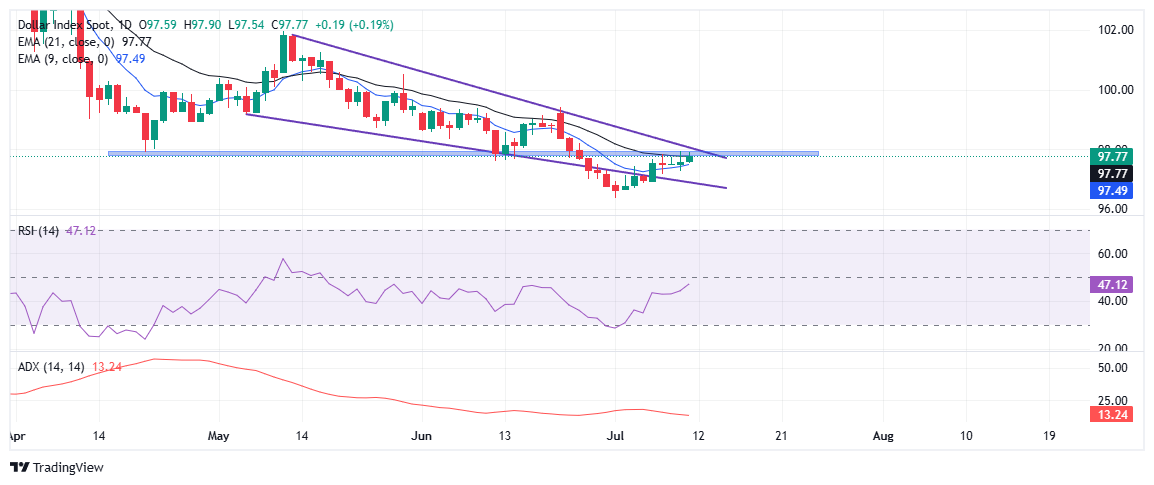- The US dollar gains strength on Friday, driven by renewed tariff threats of the US president, Trump, and the decrease in expectations of interest rate cuts of the Fed in the short term.
- Trump points to Canada with a 35%tariff, citing concerns about fentanyl and commercial imbalances.
- The DXY is maintained below the key resistance at 97.80–98.00, with the price supported by 97.50 EMA in 97.50
He Dollar American gains strength on Friday, supported by the renewed tariff threats of US President Donald Trump, who have revived global commercial tensions and caused a new wave of risk aversion. As tensions increase, investors become more and more cautious, favoring the status of the dollar as a safe refuge. This change in the feeling has driven the American dollar index (DXY) up, while markets are prepared for possible changes in monetary policy.
The American dollar index (DXY), which measures the value of the dollar against a main currency basket, is rising before the American session. At this time, the index is quoted about 97.84, with an increase of around 0.20% in the day, although it faces a confluence of key technical barriers.
US President Donald Trump has climbed tariff tensions this week by sending warning letters to more than 20 countries, including important commercial partners such as Canada, Japan and South Korea, as well as threatening smaller economies with tariffs ranging from 15% to 50%, according to the commercial relationship of each country with the United States (USA). The letters, shared on Trump’s social networks, Truth Social, reflect their hard position on trade and are a warning that the US will impose broad “reciprocal” tariffs unless commercial partners accept more favorable terms.
As part of the last impulse, Trump announced a 35% tariff on Canadian imports, effective as of August 1. In an official letter to the Canadian Prime Minister Mark Carney, the US president cited Canada’s alleged inability to prevent the flow of fentanyl towards the US, as well as long -standing commercial imbalances and high tariffs on US dairy exports. The document warned that any retaliation tariff imposed by Canada would be responded with additional equivalent taxes, in addition to 35%. Trump also emphasized that transbounded goods through Canada to avoid tariffs would be subject to the highest rate, unless they are manufactured within the US.
In addition, the US president has indicated that all the remaining commercial partners who have not yet received specific tariff letters or finished trade agreements will be beaten with general tariffs of 15% or 20%. Trump also added that some countries could be excused if they accept better agreements. Economists warn that such general measures could increase import costs, enliven inflation and cause retaliation actions, causing global commercial negotiations to be more tense in the coming months.
Market movements: stable treasure yields, fed cautious about the repercussions of tariffs
- The USD/CAD shot almost 0.5% to a maximum of 1,3731 before going back below 1,3700, after the announcement of President Trump about new tariffs on Canadian imports. An American official later clarified that 35% tariffs will apply only to goods not covered by the treaty between Mexico, the United States and Canada (T-MEC). The last tariff movement seems to be a strategic pressure tactic aimed at pushing Canada to end a commercial agreement reviewed with the USA before the deadline of July 21. This deadline was established by Canadian Prime Minister Mark Carney after a meeting with Trump at the G7 summit in Canada in mid -June. It was framed as a period of 30 days to negotiate a new economic and security relationship.
- The 10 -year American treasure bonus yield was stabilized around 4.36% on Friday, ending a volatile week marked by growing commercial tensions and changing expectations around the monetary policy of the Federal Reserve. The feeling of investors remained cautious, with ETFs focused on treasure seeing a strong increase in tickets, indicating a greater demand for shelter assets. The strengthening of long -term yields reflects a cautious economic perspective and can play a key role in the short -term direction of the US dollar.
- With the expectations of interest rate cuts of the Federal Reserve (Fed) fading, the US dollar continues to receive support, also reinforced by recent signs of strength in the US labor market. The initial applications of weekly unemployment subsidy were lower than expectations for the third consecutive week, reinforcing the opinion that the economy remains resistant.
- Speaking on Thursday, Fed officials suggested that new tariffs may not lead to a sharp increase in consumer prices. The president of the Fed of San Francisco, Mary Daly, said that tariffs “simply do not translate into a great increase in prices inflation for consumers because companies find ways to adjust.” Reflecting this opinion, the president of the Chicago Fed, Austen Goolsbee, said that the impact on inflation has so far been “surprisingly little,” indicating that price pressures can continue contained even as commercial tensions increase.
- Also on Thursday, the governor of the Fed, Christopher Waller, reaffirmed his support for a feat cut in July, stating that “inflation has dropped enough to justify a movement – and tariffs should not necessarily be a reason to delay.” Meanwhile, the president of the Fed of St. Louis, Alberto Musalem, said: “It will take time for tariffs to settle. We could be in the fourth quarter of this year, or in the first or second quarter of next year, where the tariffs are still being integrated into the economy.”
- In general, the solid economic background of the United States gives the Fed time to assess the impact of recent tariff ads on inflation and growth before proceeding with more feats of fees. According to the CME Fedwatch tool, markets are valuing only 6.7% probability of an interest rate cut of 25 basic points in July, a 62.2% probability of a cut in September, considering approximately 100 basic points of total flexibility over the next 12 months.
Technical analysis: The index of the US dollar is consolidated below 98.00, a technical breakout is coming

The American dollar index (DXY) is quoted about 97.84 on Friday, with modest profits as it approaches a key technical area. The index is just below the 21-day exponential (EMA) mobile average, currently in 97.77, which is aligned with the upper limit of a descending wedge pattern and the area of 97.80-98.00, an anterior support area that now acts as a resistance. This confluence forms a short -term crucial barrier. A decisive rupture above this level could confirm a bull reversal, opening the door towards 98.50, near the maximum of June 24.
At the bottom, the 9 -day EMA is acting as a short -term dynamic support about 97.50, helping to cushion recent setbacks. This level has been consistently maintained during the three days, limiting the downward pressure while the US dollar is consolidated within a restricted range.
The Momentum indicators are showing early recovery signs, with the relative force index (RSI) rising to 47.12, although still below the neutral level of 50, which suggests that the momentum is still in development. The average directional index (ADX) in 13.2 reflects a weak general trend, indicating that a clear directional breakout has not yet materialized. While the broader configuration seems cautiously constructive, the bulls need a strong daily closure above 98.00 to confirm a sustained potential.
American dollar today
The lower table shows the percentage of US dollar change (USD) compared to the main coins today. American dollar was the strongest currency against the Japanese yen.
| USD | EUR | GBP | JPY | CAD | Aud | NZD | CHF | |
|---|---|---|---|---|---|---|---|---|
| USD | 0.13% | 0.55% | 0.56% | 0.31% | 0.17% | 0.46% | -0.04% | |
| EUR | -0.13% | 0.41% | 0.45% | 0.17% | 0.12% | 0.31% | -0.16% | |
| GBP | -0.55% | -0.41% | 0.04% | -0.25% | -0.29% | -0.02% | -0.60% | |
| JPY | -0.56% | -0.45% | -0.04% | -0.24% | -0.39% | -0.13% | -0.62% | |
| CAD | -0.31% | -0.17% | 0.25% | 0.24% | -0.08% | 0.13% | -0.36% | |
| Aud | -0.17% | -0.12% | 0.29% | 0.39% | 0.08% | 0.35% | -0.29% | |
| NZD | -0.46% | -0.31% | 0.02% | 0.13% | -0.13% | -0.35% | -0.54% | |
| CHF | 0.04% | 0.16% | 0.60% | 0.62% | 0.36% | 0.29% | 0.54% |
The heat map shows the percentage changes of the main currencies. The base currency is selected from the left column, while the contribution currency is selected in the upper row. For example, if you choose the US dollar of the left column and move along the horizontal line to the Japanese yen, the percentage change shown in the box will represent the USD (base)/JPY (quotation).
Source: Fx Street
I am Joshua Winder, a senior-level journalist and editor at World Stock Market. I specialize in covering news related to the stock market and economic trends. With more than 8 years of experience in this field, I have become an expert in financial reporting.







